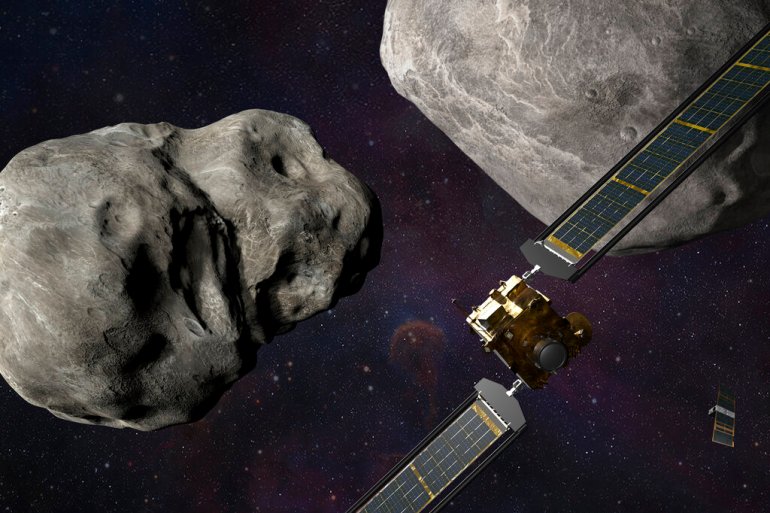 NASA’s Double Asteroid Redirection Test (DART) spacecraft will hit the asteroid Dimorphos about 11 million kilometres from Earth on Monday evening [Steve Gribben/Johns Hopkins APL/NASA via AP
NASA’s Double Asteroid Redirection Test (DART) spacecraft will hit the asteroid Dimorphos about 11 million kilometres from Earth on Monday evening [Steve Gribben/Johns Hopkins APL/NASA via APA NASA spacecraft is scheduled to slam into an asteroid, in an unprecedented test designed to prevent potentially devastating collisions with Earth.
NASA’s Double Asteroid Redirection Test (DART) spacecraft will hit the asteroid Dimorphos about 11 million kilometres from Earth on Monday, attempting to slightly alter its trajectory in a test of the world’s first planetary defence system.
“This is a challenging test, and this is why we’re taking these first steps now to develop this technology before we need it,” Nancy Chabot, the mission coordination lead, told Al Jazeera just hours before the scheduled impact.
The DART spaceship launched from California in the United States last November and is fast approaching its target, which it will strike at roughly 22,500km per hour (14,000 miles per hour) around 7:14pm Eastern Time (23:14 GMT).
“It’s the final cosmic collision countdown,” tweeted mission control at the Johns Hopkins University Applied Physics Laboratory (APL) in the US state of Maryland.
The asteroid is not on course to collide with Earth, but Monday’s test marks the first effort to change the trajectory of an asteroid using only kinetic force – and scientists hope that the method could be used to nudge asteroids and prevent cataclysmic collisions.
A camera will send back images during the final approach and collision, which will be streaming live on NASA TV starting an hour before impact. DART has made most of its journey with the guidance of NASA flight directors.
An autonomous navigation system will take over in the final hours of the voyage, which will be monitored in real time from the mission operations centre at APL in Laurel, Maryland.
The target is an asteroid “moonlet” about 170m in diametre that orbits an asteroid about five times larger, called Didymos.
Smaller asteroids are more common and thus a greater concern in the near term, making the Didymos pair suitable test subjects for their size, according to NASA scientists and planetary defence experts.
Their relative proximity to Earth and dual-asteroid configuration also make them strong subjects for the first proof-of-concept mission of DART.
The outcome of the test will not be verified until a new round of ground-based telescopes can observe the asteroid pair in October.
The DART team hopes to shorten the orbital track of Dimorphos by 10 minutes but would consider at least 73 seconds adequate to prove that the method could be used to deflect asteroids.
The cost of the project is estimated to be about $330m, far below many of NASA’s more ambitious space missions.
DART is the latest of several NASA missions in recent years focused on exploring asteroids, rocky remnants from the solar system’s formation more than 4.5 billion years ago.
